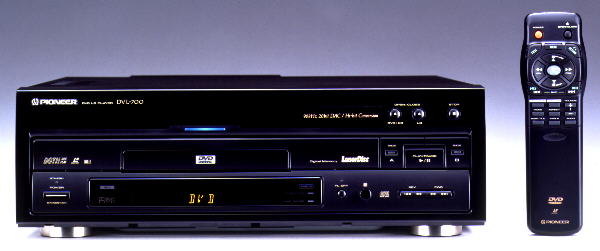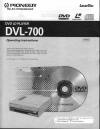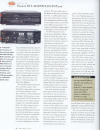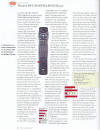Pioneer DVL-700

Pioneer DVL-700 - Laserdisc/DVD Player
The archive site has a copy of the Operation Manual for the DVL-700. Please see the manuals page.
The world's first DVD/Laser combination player. The DVD-700 combines the laser disc performance of past 700 series machines with the convenience of playing the new 5" Digital Video Discs. Features include double-side laser disc play, optical and coax digital AC-3 subcarrier outputs for both laser and DVD discs, separate loading drawers for 5" and 12" discs, full digital effects on CLV format laser discs, PCM digital output for DTS decoding, S-video outputs, "heads up" wireless remote control, on-screen graphical user interface (GUI).
Pioneer's DVL-700 ($1200) was the first "main line" LaserDisc player to boast DVD playback capability and is at the top of the standard lineup. Pioneer also offered the Elite model, DVL-90 ($1750) with the same basic features, but some view it as an inferior model due to its early development.
 The DVL-700 is by far, the best LD player I have ever had the pleasure of using.
In every area it excels... Tracking, video noise, chroma noise, drop outs,
digital sound, analog CX sound, side changing time, stop to play speed,
quietness of operation... you name it, the DVL-700 is phenomenal. And, best of
all, it even plays the majority of DiscoVision titles wonderfully...you can even
get some of those defective DiscoVision discs to play back without a hop, skip
or jump. The picture from a well made LD is just fantastic. Chroma noise is
basically nonexistent, and the sharpness and lack of video noise will push your
television set to its very limits. Black level detail and dynamic range of the
picture are just incredible, with small details of the image that you have never
seen before "popping out" at you. CLV titles which exhibit crosstalk
on other LD players show absolutely none on the DVL-700. It also handles disc
defects very well, requiring a major defect before it behaves abnormally. The
CLV Digital Field memory is the best I have ever seen from a Pioneer player.
Previous LD players with digital field memory have used an 8-bit AD-DA
converter, which is considered the bare minimum needed for a good picture.
Pioneer has refined the 8-bit system which effectively removes the
"steps" that used to be seen in shallow, ramped transitions, such as
the underwater lighting in the movie THE ABYSS. With older LD players, engaging
CLV Still frame would cause a loss of vertical resolution since only 1/2 a frame
was being held, and an increase in video noise (showing up as "snow) with
some minor digital artifacts. The 700 is so good that the CLV still frame
performance looks just like a CAV still frame.
The DVL-700 is by far, the best LD player I have ever had the pleasure of using.
In every area it excels... Tracking, video noise, chroma noise, drop outs,
digital sound, analog CX sound, side changing time, stop to play speed,
quietness of operation... you name it, the DVL-700 is phenomenal. And, best of
all, it even plays the majority of DiscoVision titles wonderfully...you can even
get some of those defective DiscoVision discs to play back without a hop, skip
or jump. The picture from a well made LD is just fantastic. Chroma noise is
basically nonexistent, and the sharpness and lack of video noise will push your
television set to its very limits. Black level detail and dynamic range of the
picture are just incredible, with small details of the image that you have never
seen before "popping out" at you. CLV titles which exhibit crosstalk
on other LD players show absolutely none on the DVL-700. It also handles disc
defects very well, requiring a major defect before it behaves abnormally. The
CLV Digital Field memory is the best I have ever seen from a Pioneer player.
Previous LD players with digital field memory have used an 8-bit AD-DA
converter, which is considered the bare minimum needed for a good picture.
Pioneer has refined the 8-bit system which effectively removes the
"steps" that used to be seen in shallow, ramped transitions, such as
the underwater lighting in the movie THE ABYSS. With older LD players, engaging
CLV Still frame would cause a loss of vertical resolution since only 1/2 a frame
was being held, and an increase in video noise (showing up as "snow) with
some minor digital artifacts. The 700 is so good that the CLV still frame
performance looks just like a CAV still frame.
Pioneer has greatly improved their video noise reduction system, giving a clear, detailed picture that is pretty much transparent. Discs that would previously show chroma noise in solid red scenes now look like a perfect pressing, with rock solid reds and no streaking. The little random black line drop-outs that could be seen so well in red fields are now completely gone, and red and blue speckles from LaserRot and "inclusion" are dramatically reduced. In many cases, the improvement is so great that it looks like the difference between what would be called a "perfect" disc and one that is defective.
The digital adaptive 3-D Y/C separation has also been improved. It has better Y/C separation in even the absolute best video monitors and since it is clocked directly to the turntable motor, picture jitter is dramatically reduced over what a video monitor could achieve. The 3 Dimensional Digital Comb Filter is a unique technology that is adaptive in nature. Not only does it analyze several different scan lines in its process, similar to the 3-line digital comb filter used in previous LD players, but is also has the capacity to analyze two frames simultaneously. Since motion in a NTSC system is comprised of 30 frames per second the information contained in frame 1 and frame 2 is usually very similar. With this in mind, Pioneer was able to develop a system that compares not only three lines in one frame, but also compares that information to the corresponding lines of the previous frame. This 3 Dimensional comparison allows for a more precise separation of the chrominance from the luminance due to these additional parameters. However, if the motion in the scene is too rapid for this two-frame correlation, then the system defaults back to the 3-Line Digital Comb Filter. Until now, the 3-D Digital Comb Filter had only been used in Elite series models and was developed originally for Pioneer's Reference player, the LD-S2. The DVL-700 marks the first appearance of such an advanced comb filter in a base line model. The results of the 3-D comb filter look almost as good as a true component source. Dot crawl is almost non-existent, and color boundaries are very sharply defined with no bleed or spillage. A Video Standard shows this effect clearly.
CD audio and LD Digital Audio playback is also very good, with a smooth, coherent high-end and a very powerful bass. Tests show that the DVL-700 achieves pretty much perfect 16-bit performance with just the tiniest bit of gain related analog distortion. THD+N is also very good and shows that jitter is well controlled. Analog CX performance is quite good, showing an improvement over recent models. The Epsilon turn mechanism for LD playback is Pioneers best ever, changing sides in a quick 5.5 seconds. It's quiet too, with none of the noise and rattles that plagued earlier players.
Like all DVD players, the DVL-700 can provide a mixdown from 5.1 channel soundtrack down to a 2-channel Dolby MP encoded signal. In the process, some of the dynamic range and "oomph" of the soundtrack are lost. This may be a fault of the mastering and how the mixdown is programmed.
Special effects on DVD are also nothing like what we are used to. They are quite limited when compared to those available on LaserDisc. Scanning is not the smooth process we have seen on LaserDisc and is instead a herky-jerky system that skips anywhere from 30 seconds to 2 minutes at a time. This makes it very difficult to find an exact scene. Still Frame reverse is not possible with the DVL-700, nor is slow motion reverse. The effects in the forward direction are possible though. Also missing are the typical LaserDisc staples of X2 and X3 fast play.
With the addition of DVD capability, Pioneer, removed many standard LaserDisc features. Chief among these is the ability to manually activate CX Noise Reduction on old analog only titles that don't contain the Auto-CX code. As a result, on playback of discs made prior to 1983, you are at the mercy of the intrinsic noise level of the disc and are stuck with the 2:1 compression of the CX Noise Reduciton system. The other missing features are lack of a Jog/Shuttle dial and x1 reverse -x2,x3 forward and reverse playback. Likely omitted so as to not cause a "suffer by comparison" aspect to DVD.




